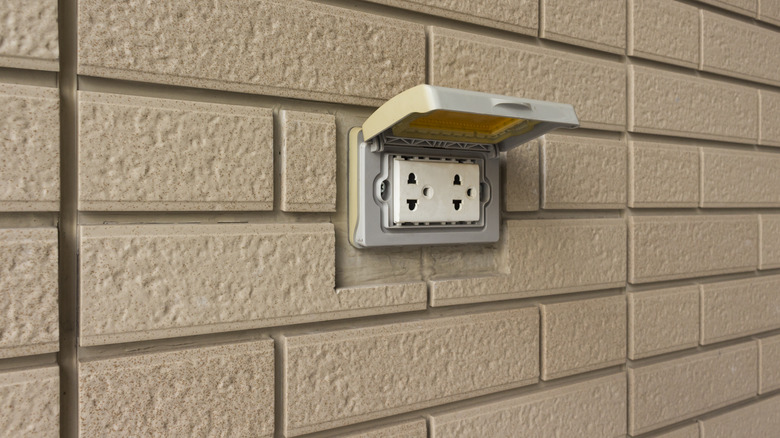
You’re pressure washing the side of your home, everything’s going great… then you spot it: a wall-mounted electrical outlet or an outdoor light fixture. Suddenly, the stakes feel a lot higher. You pause and think—
“Is it actually safe to pressure wash near this thing?”
⚠️ Short answer: Not unless you take precautions. ⚠️
Mixing high-pressure water with electricity is never something to take lightly. While many modern outdoor fixtures are rated for some weather exposure, pressure washers produce far more force than rain or a garden hose. That means, without care, you could face:
- Electrical shock
- Damage to wiring
- Short circuits
- Water intrusion that leads to mold or corrosion
Let’s break down how to do this safely and what steps can help you avoid a costly mistake—or worse, a dangerous one. 🧠
⚡ Why It’s Risky
Pressure washers deliver 1,200 to 3,000 PSI or more, which can:
- Force water into outlet seams, even if they’re sealed
- Crack plastic outlet covers
- Push moisture into wiring boxes, light fixtures, or conduit
- Dislodge waterproof caulk or gaskets around fixtures
Once water enters the system, it doesn’t always cause immediate failure—it can corrode wiring over time or create a hidden shock hazard later on. That’s why it’s essential to prevent water from getting in at all.
🔌 Types of Electrical Fixtures to Watch For
You’ll most commonly encounter:
- Outdoor GFCI outlets
- Wall-mounted light fixtures
- Breaker boxes or electrical panels
- Air conditioning units
- Cable, phone, or internet boxes
- Security system components
Even if these are rated for outdoor use, they’re not designed to withstand a direct blast from your pressure washer. 🧯
Browse Amazon Here For Popular Pressure Washers And Accessories
🧽 How to Pressure Wash Around Electrical Areas Safely
✅ 1. Turn Off Power if Possible
If you can, shut off the power to the circuit that feeds the outlet or fixture you’ll be washing near. This prevents any electrical current from flowing in the event of water intrusion.
💡 Can’t turn it off? Be extra cautious with coverage and spray angles.
✅ 2. Cover Outlets and Fixtures Tightly
Use:
- Plastic bags or waterproof sheeting
- Duct tape or painter’s tape to seal edges
- Rubber outlet covers for extra protection (these are worth installing if you pressure wash regularly)
Make sure the seal is tight—no water should be able to seep in.
🧠 Pro Tip: Double-wrap for extra safety. Tape down one layer of plastic, then secure a second one over that.
✅ 3. Maintain a Safe Distance
Stay at least 3 to 5 feet away from any electrical source. The closer you are, the higher the pressure impact and the more likely water will force its way in.
Use a wide-angle nozzle (25° or 40°) and avoid spraying directly at the fixture—spray downward or sideways instead.
✅ 4. Use Low Pressure
If your pressure washer has an adjustable PSI or soft-wash setting, use it. Aim for under 1,500 PSI near electrical areas. This helps minimize the chance of water intrusion or cracking the housing.
✅ 5. Inspect Before and After
Before you begin:
- Check for cracks in outlet covers
- Look for worn seals or damaged gaskets
- Tighten any loose fixtures
After washing:
- Remove coverings carefully
- Check for any signs of moisture or corrosion
- Test outlets only after they’re fully dry
🚫 What NOT to Do
- ❌ Don’t use a 0° or 15° nozzle near any electrical component
- ❌ Don’t spray from underneath or into seams
- ❌ Don’t rely solely on “weatherproof” labels—pressure washers are far more intense than rain
- ❌ Don’t ignore cracked covers—replace them before washing
- ❌ Don’t assume it’s dry inside—wait several hours or use a moisture meter to be sure
🧰 When in Doubt, Call a Pro
If you’re:
- Not sure how to shut off power
- Dealing with old or exposed wiring
- Washing close to your electrical panel or main meter
…it’s best to have a professional evaluate it first or handle the job altogether.
A small mistake with electricity can lead to big consequences, both for your safety and your wallet. 💸⚡
🧠 Final Thoughts
Pressure washing and electricity don’t mix—unless you take the right precautions. With proper coverage, controlled pressure, and a safe distance, you can clean around electrical fixtures without risking damage or danger. ⚠️💦
To recap:
- ✅ Cover outlets and fixtures with waterproof barriers
- 🔌 Turn off power to nearby circuits if possible
- 🌊 Use low pressure and wide-angle nozzles
- ↘️ Spray at an angle, not directly
- 🕵️♂️ Inspect for damage before and after
Clean smart, stay safe, and let your home shine without shocking surprises. ⚡🏡💧
Browse Amazon Here For Popular Pressure Washers And Accessories






